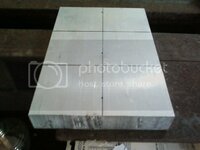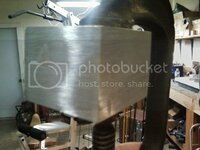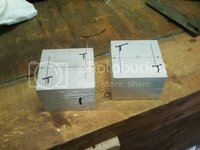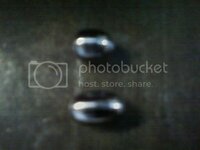you will lose track of how many times you press a jighead blank, and a hook and knock the pins out between all this to resurface the mold halves, only to press this stuff again and repeat, nevermind a two cavity mold. lol I also press a tiny drill bit in the place where I want my sprue hole, and then later drill it a little bigger. by the time you get your mold close to being done the pins will be looser than when you started.
alot of the reason you will be pressing and refacing so much is that evrytime you press something like a jighead blank or a hook it will cause a bulge in the alum. around it, also pressing the head will bulge alum. into the end of the hook slot and vise versa, so it's back and forth.
there is another method that I would not be afraid to try if I didn't have a jack and a frame, and I used this method on my first mold quite a bit with success.
this involves laying the mold on a sturdy steel surface that is flat, like an anvil platen, then laying a 1/2" thick peice of steel or iron on top of the mold to protect it.
then with your jighead blank sandwiched between the mold halves, strike the steel plate directly over top dead center, of your mold especially the part of the mold where the jighead blank is located, in other words you want a straight down force directly over top the jighead blank.
only strike it once, then pull your mold apart and check your progress.
I always tape jighead blanks and hooks down to the mold surface, before I put the mold halves together for pressing, with cellophane tape, it won't interfere and I can be sure nothing has shifted while sliding the mold halves together.





